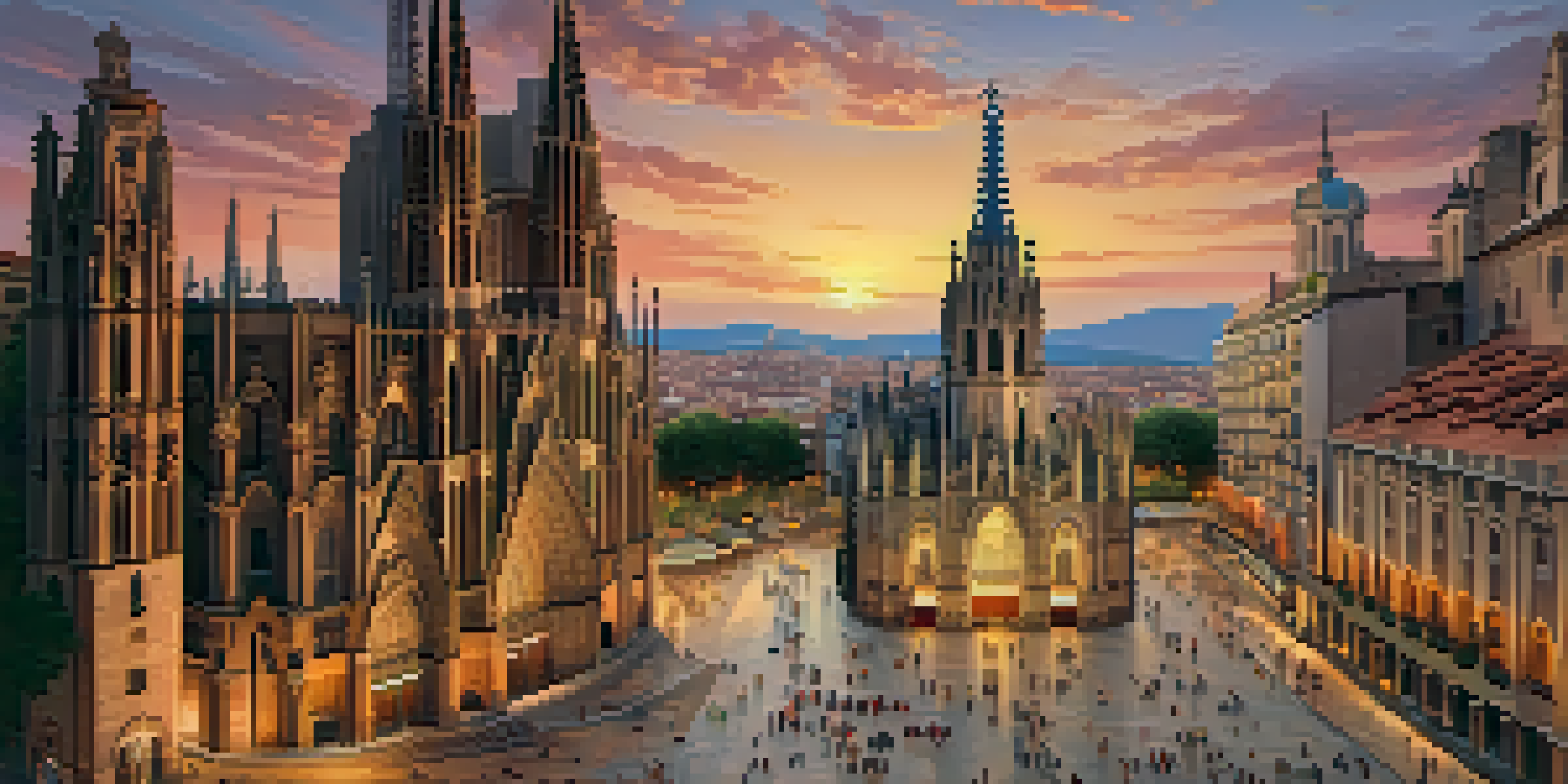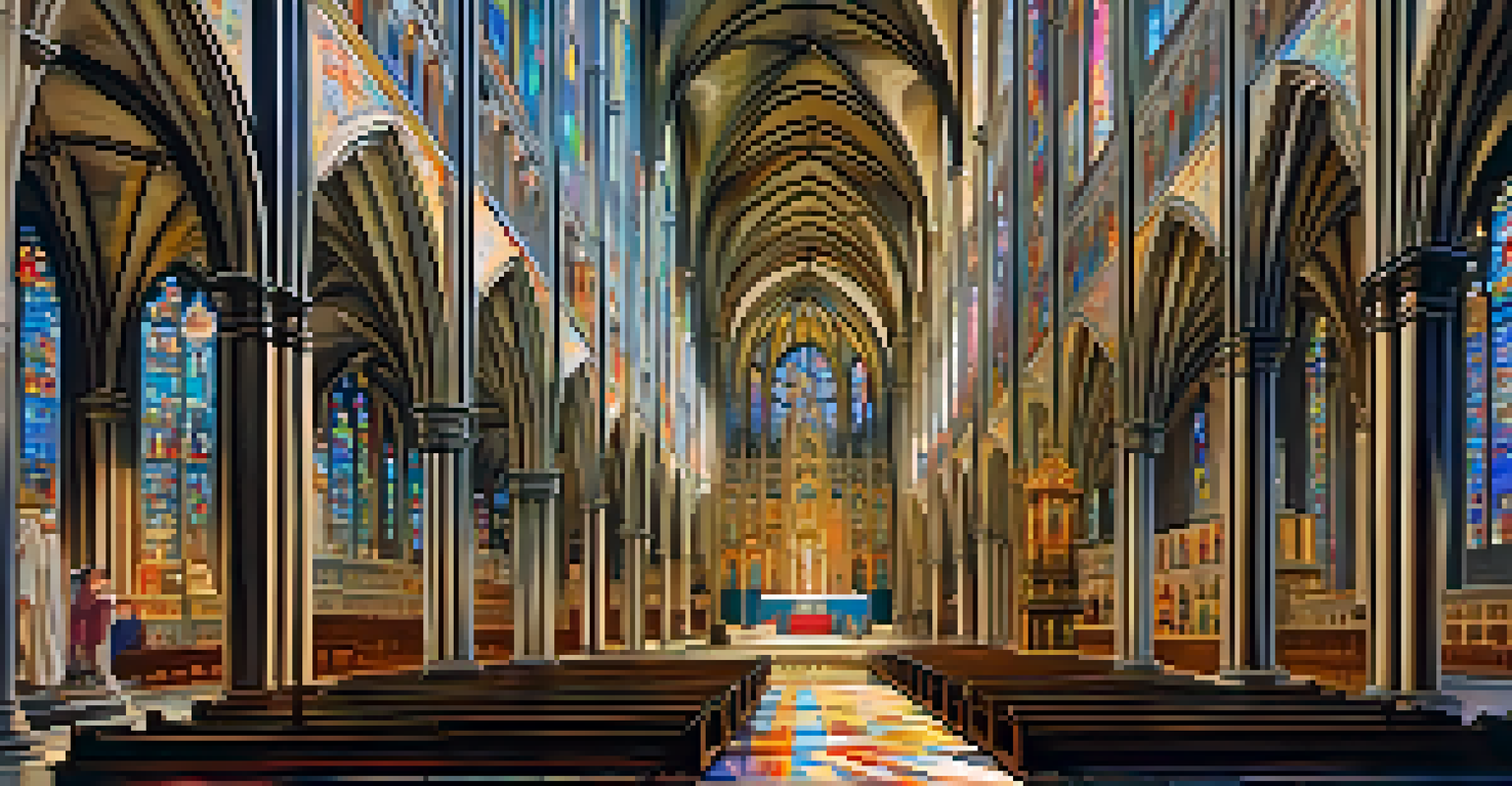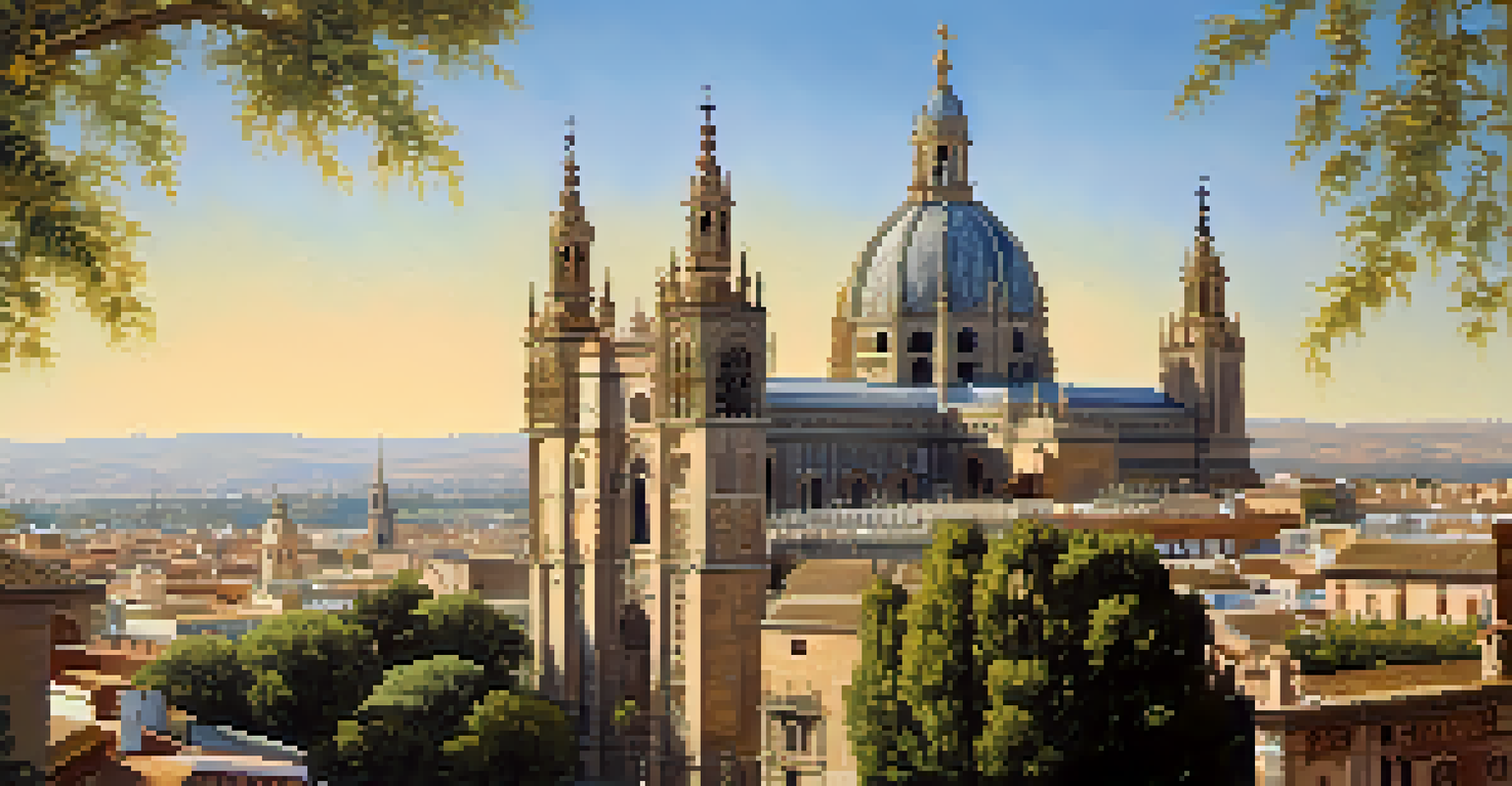Exploring Spain's Gothic Cathedrals: A Majestic Journey

Introduction to Spain's Gothic Cathedrals
Spain’s Gothic cathedrals are not just places of worship; they are architectural marvels that tell stories of the past. With their towering spires and intricate details, these structures showcase the grandeur of medieval architecture. Each cathedral serves as a testament to the craftsmanship and devotion of those who built them, creating a lasting legacy that continues to captivate visitors.
Architecture is the art of how to waste space.
As we embark on this majestic journey, we’ll explore the historical significance, unique features, and cultural impact of these stunning edifices. From the bustling streets of Barcelona to the serene landscapes of Toledo, each city has its own gem waiting to be discovered. These cathedrals not only represent religious devotion but also the artistic spirit of their time.
So grab your walking shoes and your camera, and let’s delve into the enchanting world of Spain's Gothic cathedrals. Whether you’re an architecture enthusiast or a casual traveler, there’s something here for everyone to appreciate.
The Architectural Style of Gothic Cathedrals
Gothic architecture emerged in the 12th century and reached its peak in the 13th and 14th centuries, characterized by features like pointed arches, ribbed vaults, and flying buttresses. These elements not only added to the aesthetic beauty of cathedrals but also provided structural stability, allowing for taller and more luminous buildings. Imagine standing in a vast hall where sunlight streams through stained glass, creating a kaleidoscope of colors.

One of the most striking examples is the Cathedral of Santiago de Compostela, renowned for its intricate façade and stunning interior. This magnificent structure showcases how Gothic architecture evolved to incorporate local styles and materials, giving each cathedral a unique personality. The blend of functionality and artistry in these designs reflects the ingenuity of medieval builders.
Gothic Cathedrals: Architectural Marvels
Spain's Gothic cathedrals are stunning examples of medieval architecture, showcasing intricate designs and historical significance.
As you explore these cathedrals, take a moment to appreciate the details—the gargoyles, the ornate columns, and the soaring ceilings. Each element contributes to the overall narrative, inviting visitors to connect with history and artistry on a deeper level.
The Cathedral of Barcelona: A Stunning Marvel
The Cathedral of Barcelona, or La Seu, is a prime example of Gothic architecture in Spain. Built over several centuries, its façade boasts stunning spires that rise above the city, making it a focal point of Barcelona’s skyline. As you step inside, the soaring ceilings and intricate altarpieces create a sense of awe that is hard to match.
Cathedrals are the great books of the people; they tell the story of our lives and of our faith.
What sets La Seu apart is its blend of styles, with elements from both the Gothic and neo-Gothic periods. The delicate details of the stained glass windows tell stories from the Bible, illuminating the interior with vibrant colors. It’s like walking through a living painting, where each window serves as a portal to another time.
Visiting this cathedral is not just about admiring its beauty; it’s also about experiencing the vibrant atmosphere that surrounds it. The lively plazas and bustling streets nearby add to the charm, making it a perfect spot to soak in the essence of Barcelona.
The Majestic Cathedral of Toledo
Toledo's Cathedral, known as the Primada, is a stunning blend of Gothic and Mudejar architectural styles. Its grand entrance and striking spires make it one of the most significant cathedrals in Spain. As you approach, the intricate carvings and detailed sculptures draw you in, inviting exploration of its many secrets.
Inside, the cathedral boasts an impressive collection of art, including works by renowned artists like El Greco. The soaring nave and stunning altarpiece create an atmosphere that feels both sacred and welcoming. Imagine standing beneath the dazzling stained glass, feeling a sense of peace wash over you as the sunlight dances across the stone floors.
Cultural Hubs and Community Life
These cathedrals serve as vibrant centers for social and cultural events, reflecting the identity and heritage of their communities.
Beyond its architectural beauty, the Primada is steeped in history, having witnessed significant events throughout the centuries. This rich tapestry of stories adds layers of meaning to your visit, making it more than just a sightseeing stop—it's a journey through time.
The Gothic Splendor of Seville Cathedral
Seville Cathedral, the largest Gothic cathedral in the world, is an awe-inspiring site that cannot be missed. Its grandeur is evident from the moment you approach, with the towering Giralda bell tower standing as a sentinel over the city. Entering this cathedral is like stepping into a different realm, where history and artistry converge seamlessly.
One of the cathedral's most remarkable features is the extensive use of gold in its interior, particularly in the Capilla Mayor. The opulence of the design reflects the wealth and power of the period, making it a stunning visual experience. You’ll find yourself captivated by the intricate altarpieces and the serene beauty of the chapels that line the nave.
A visit to Seville Cathedral is not complete without climbing the Giralda. The panoramic views from the top are breathtaking, offering a unique perspective of the city that blends history with modern life. This journey to the top is well worth the effort, providing a memorable highlight to your Gothic cathedral exploration.
Exploring Unique Features of Spanish Cathedrals
Each Gothic cathedral in Spain has its unique features that reflect local influences and histories. For instance, the Cathedral of Burgos is celebrated for its stunning ribbed vaults and intricate sculptures that tell biblical stories. These unique elements help each cathedral to stand out, showcasing the diversity within Gothic architecture.
Another fascinating aspect is the use of local materials, which gives each cathedral a distinct character. For example, the reddish stone of the Cathedral of León contrasts beautifully with its detailed carvings, creating a unique visual appeal. This connection to the land not only enhances the architectural beauty but also cements the cathedral's place in its community.
Unique Features Across Regions
Each cathedral presents unique architectural elements and local materials, highlighting the diversity and artistry within Gothic design.
As you explore these magnificent structures, take the time to notice these unique features. They serve as reminders of the rich history and cultural significance that each cathedral holds, inviting you to appreciate the artistry and dedication that went into their creation.
Cultural Significance of Spain's Cathedrals
Spain's Gothic cathedrals play a vital role in the cultural and spiritual life of their communities. They are not only places of worship but also venues for important social and cultural events. Festivals, concerts, and art exhibitions often take place within their walls, making them vibrant centers of community life.
These cathedrals also serve as symbols of national pride and identity, reflecting the history and values of the regions they inhabit. For example, the Cathedral of Santiago de Compostela is a pilgrimage site, attracting thousands of visitors each year who seek spiritual fulfillment and connection to their heritage. This blend of faith and culture creates a rich tapestry that defines Spanish society.

As you visit these cathedrals, consider their role beyond architecture. They are living monuments, filled with stories and experiences that connect generations of people. Engaging with this cultural significance will deepen your appreciation for the beauty and meaning of these majestic structures.
Planning Your Visit to Spain's Gothic Cathedrals
As you prepare for your journey to explore Spain's Gothic cathedrals, consider the best times to visit. Many cathedrals offer guided tours, which can enhance your understanding of their history and architecture. Booking in advance, especially during peak tourist seasons, can save you time and ensure you don’t miss out on these breathtaking sites.
Don’t forget to check for any special events or services taking place during your visit. Many cathedrals host concerts or religious events that can provide a unique experience beyond the typical sightseeing. Engaging with the local culture in this way can create lasting memories.
Lastly, take your time to soak in the atmosphere. Each cathedral has its own rhythm; find a quiet spot to reflect or simply admire the craftsmanship around you. With a little planning and an open heart, you’re sure to have an unforgettable experience exploring these majestic Gothic treasures.